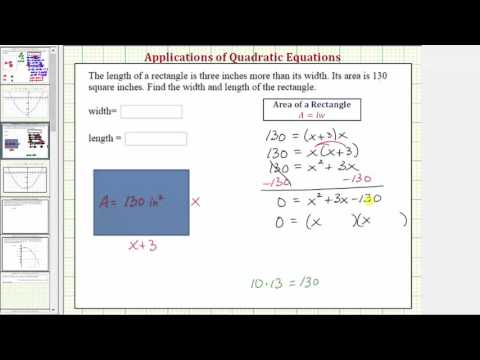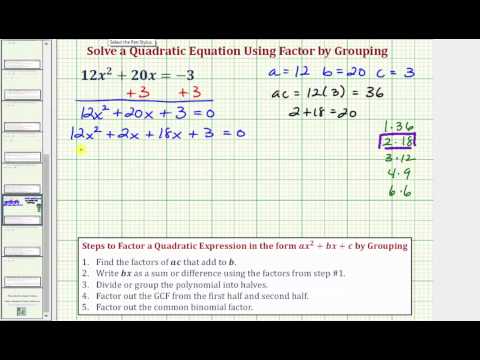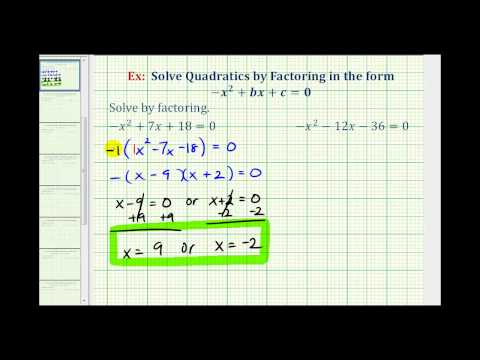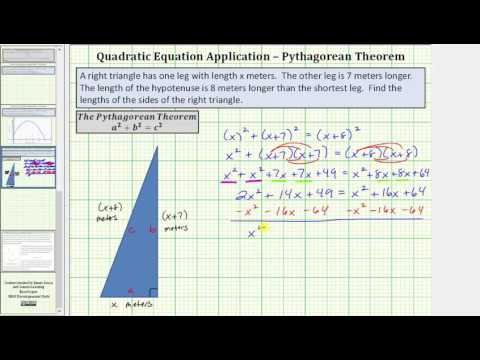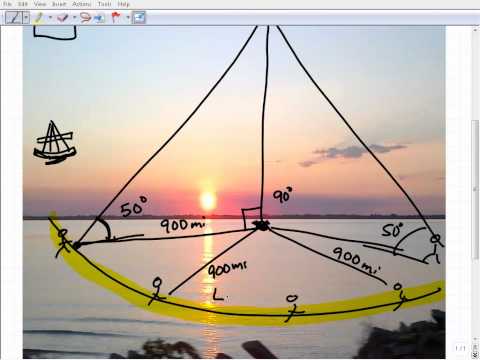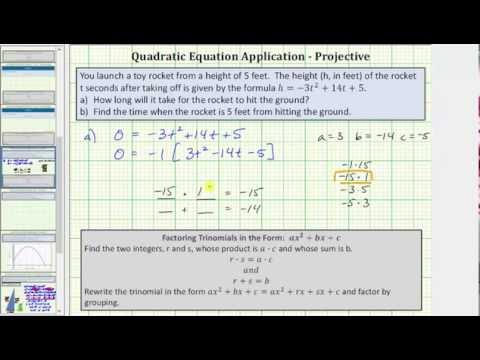6.5: Quadratic Equations
- Page ID
- 51472
Learning Objectives
- Quadratic Equations
- Recognize a quadratic equation
- Use the zero product principle to solve a quadratic equation that can be factored
- Determine when solutions to quadratic equations can be discarded
- Pythagorean Theorem
- Recognize a right triangle from other types of triangles
- Use the Pythagorean theorem to find the lengths of a right triangle
- Projectiles
- Define projectile motion
- Solve a quadratic equation that represents projectile motion
- Interpret the solution to a quadratic equation that represents projectile motion
When a polynomial is set equal to a value (whether an integer or another polynomial), the result is an equation. An equation that can be written in the form \(ax^{2}+bx+c=0\) is called a quadratic equation. You can solve a quadratic equation using the rules of algebra, applying factoring techniques where necessary, and by using the Principle of Zero Products.
There are many applications for quadratic equations. When you use the Principle of Zero Products to solve a quadratic equation, you need to make sure that the equation is equal to zero. For example, \(12x^{2}+11x+-5=0\) by subtracting 7 from both sides.
Example
The area of a rectangular garden is 30 square feet. If the length is 7 feet longer than the width, find the dimensions.
[reveal-answer q=”948371″]Show Solution[/reveal-answer]
[hidden-answer a=”948371″]The formula for the area of a rectangle is \(A=l\cdot{w}\).
\(\begin{array}{l}\,\,\,\,\,\,\,\,\,\,\,\,A=l\cdot{w}\\\,\text{width}=w\\\text{length}=w+7\\\,\,\,\,\,\text{area}=30\\\\30=\left(w+7\right)\left(w\right)\end{array}\)
Multiply.
\(30=w^{2}+7w\)
Subtract 30 from both sides to set the equation equal to 0.
\(w^{2}+7w–30=0\)
Find two numbers whose product is \(10w–3w\).
\(w^{2}+10w–3w–30=0\)
Factor w out of the first pair and \(−3\) out of the second pair.
\(w\left(w+10\right)-3\left(w+10\right)=0\)
Factor out \(w+10\).
\(\left(w–3\right)\left(w+10\right)=0\)
Use the Zero Product Property to solve for w.
\(\begin{array}{l}w-3=0\,\,\,\,\,\,\text{or}\,\,\,\,\,\,w+10=0\\\,\,\,\,\,\,\,w=3\,\,\,\,\,\,\,\,\,\,\,\,\,\,\,\,\,\,\,\,\,\,\,\,w=-10\end{array}\)
The solution \(−10\). So, the width is 3 feet.
The width = 3 feet
Substitute \(w+7\) to find the length: \(3+7=10\).
The length is \(3+7=10\) feet
Answer
The width of the garden is 3 feet, and the length is 10 feet.
[/hidden-answer]
In the example in the following video, we present another area application of factoring trinomials.
The example below shows another quadratic equation where neither side is originally equal to zero. (Note that the factoring sequence has been shortened.)
Example
Solve \(5b^{2}+4=−12b\) for b.
[reveal-answer q=”950625″]Show Solution[/reveal-answer]
[hidden-answer a=”950625″]The original equation has \(12b\) to both sides.
\(5b^{2}+4+12b=−12b+12b\)
Combine like terms.
\(5b^{2}+12b+4=0\)
Rewrite \(10b+2b\).
\(5b^{2}+10b+2b+4=0\)
Factor out \(5b\) from the first pair and 2 from the second pair.
\(5b\left(b+2\right)+2\left(b+2\right)=0\)
Factor out \(b+2\).
\(\left(5b+2\right)\left(b+2\right)=0\)
Apply the Zero Product Property.
\(5b+2=0\,\,\,\text{or}\,\,\,b+2=0\)
Solve each equation.
\(b=-\frac{2}{5}\,\,\,\text{OR}\,\,\,b=−2\)
Answer
\(b=-\frac{2}{5}\,\,\,\text{or}\,\,\,b=−2\)
[/hidden-answer]
The following video contains another example of solving a quadratic equation using factoring with grouping.
If you factor out a constant, the constant will never equal 0. So it can essentially be ignored when solving. See the following example.
Example
Solve for k: \(-2k^2+90=-8k\)
[reveal-answer q=”831890″]Show Solution[/reveal-answer]
[hidden-answer a=”831890″]
We need to move all the terms to one side so we can use the zero product principle.
\(\begin{array}{l}-2k^2+90=-8k\\\underline{+8k}\,\,\,\,\,\,\,\,\,\,\,\,\,\,\,\,\underline{+8k}\\-2k^2+8k+90=0\end{array}\)
You will either need to try to factor out a -2, or use the method where we multiply \(-2\cdot{90}\) and find factors that sum to 8. Each term is divisible by 2, so we can factor out -2.
\(-2\left(k^2-4k-45\right)=0\)
Note how we changed the signs when we factored out a negative number. If we can factor the polynomial, we will be able to solve.
Using the shortcut for factoring we will start with the variable and place a plus and a minus sign in the binomials. We do this because 45 is negative and the only way to get a product that is negative is if one of the factors is negative.
\(-2\left(k-\,\,\,\right)\left(k+\,\,\,\right)=0\)
We want our factors to have a product of -45 and a sum of -4:
| Factors whose product is -45 | Sum of the factors |
|---|---|
| \(1-45=-44\) | |
| \(3-15=-12\) | |
| \(5-9=-4\) |
There are more factors that will give -45, but we have found the ones that sum to -4, so we will stop. Fill in the rest of the binomials with the factors we found.
\(-2\left(k-9\right)\left(k+5\right)=0\)
Now we can set each factor equal to zero using the zero product rule.
\(-2=0\) This solution is nonsense so we discard it.
\(k-9=0, k=9\)
\(k+5=0, k=-5\)
Answers
\(k=9\text{ and }k=-5\)
[/hidden-answer]
In this last video example, we solve a quadratic equation with a leading coefficient of -1 using the shortcut method of factoring and the zero product principle.
Pythagorean Theorem

The Pythagorean theorem or Pythagoras’s theorem is a statement about the sides of a right triangle. One of the angles of a right triangle is always equal to 90 degrees. This angle is the right angle. The two sides next to the right angle are called the legs and the other side is called the hypotenuse. The hypotenuse is the side opposite to the right angle, and it is always the longest side. The image above shows four common kinds of triangle, including a right triangle.

The Pythagorean theorem is often used to find unknown lengths of the sides of right triangles. If the longest leg of a right triangle is labeled c, and the other two a, and b as in the image on teh left, The Pythagorean Theorem states that
\(a^2+b^2=c^2\)
Given enough information, we can solve for an unknown length. This relationship has been used for many, many years for things such as celestial navigation and early civil engineering projects. We now have digital GPS and survey equipment that have been programmed to do the calculations for us.
In the next example we will combine the power of the Pythagorean theorem and what we know about solving quadratic equations to find unknown lengths of right triangles.
Example
A right triangle has one leg with length x, another whose length is greater by two, and the length of the hypotenuse is greater by four. Find the lengths of the sides of the triangle. Use the image below.
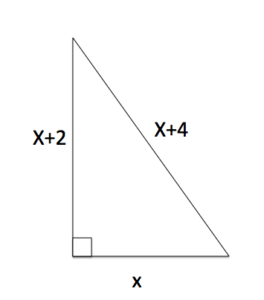
[reveal-answer q=”133740″]Show Solution[/reveal-answer]
[hidden-answer a=”133740″]
Read and understand: We know the lengths of all the sides of a triangle in terms of one side. We also know that the Pythagorean theorem will give us a relationship between the side lengths of a right triangle.
Translate:
\(\begin{array}{l}a^2+b^2=c^2\\x^2+\left(x+2\right)^2=\left(x+4\right)^2\end{array}\)
Solve: If we can move all the terms to one side and factor, we can use the zero product principle to solve. Since this is the only method we know – let’s hope it works!
First, multiply the binomials and simplify so we can see what we are working with.
\(\begin{array}{l}x^2+\left(x+2\right)^2=\left(x+4\right)^2\\x^2+x^2+4x+4=x^2+8x+16\\2x^2+4x+4=x^2+8x+16\end{array}\)
Now move all the terms to one side and see if we can factor.
\(\begin{array}{l}2x^2+4x+4=x^2+8x+16\\\underline{-x^2}\,\,\,\underline{-8x}\,\,\,\underline{-16}\,\,\,\,\,\underline{-x^2}\,\,\,\underline{-8x}\,\,\,\underline{-16}\\x^2-4x-12=0\end{array}\)
This went from a messy looking problem to something promising. We can factor using the shortcut:
\(-6\cdot{2}=-12,\text{ and }-6+2=-4\)
So we can build our binomial factors with -6 and 2:
\(\left(x-6\right)\left(x+2\right)=0\)
Set each factor equal to zero:
\(x-6=0, x=6\)
\(x+2=0, x=-2\)
Interpret: Ok, it doesn’t make sense to have a length equal to -2, so we can safely throw that solution out. The lengths of the sides are as follows:
\(x=6\)
\(x+2=6+2=8\)
\(x+4=6+4=10\)
Check: Since we know the relationship between the sides of a right triangle we can check that we are correct. Sometimes it helps to draw a picture
.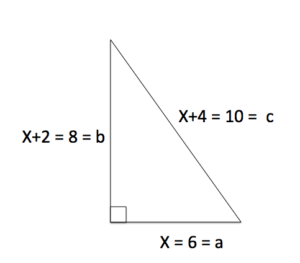
We know that \(a^2+b^2=c^2\), so we can substitute the values we found:
\(\begin{array}{l}6^2+8^2=10^2\\36+64=100\\100=100\end{array}\)
Our solution checks out.
Answer
The lengths of the sides of the right triangle are 6, 8, and 10
[/hidden-answer]
This video example shows another way a quadratic equation can be used to find and unknown length of a right triangle.
If you are interested in celestial navigation and the mathematics behind it, watch this video for fun.
Projectile Motion
Projectile motion happens when you throw a ball into the air and it comes back down because of gravity. A projectile will follow a curved path that behaves in a predictable way. This predictable motion has been studied for centuries, and in simple cases it’s height from the ground at a given time, t, can be modeled with a quadratic polynomial of the form \(\text{height}=at^2+bt+c\) such as we have been studying in this module. Projectile motion is also called a parabolic trajectory because of the shape of the path of a projectile’s motion, as in the image of water in the fountain below.

Parabolic motion and it’s related equations allow us to launch satellites for telecommunications, and rockets for space exploration. Recently, police departments have even begun using projectiles with GPS to track fleeing suspects in vehicles, rather than pursuing them by high-speed chase [1].
In this section we will solve simple quadratic polynomials that represent the parabolic motion of a projectile. The real mathematical model for the path of a rocket or a police GPS projectile may have different coefficients or more variables, but the concept remains the same. We will also learn to interpret the meaning of the variables in a polynomial that models projectile motion.
Example
A small toy rocket is launched from a 4-foot pedestal. The height (h, in feet) of the rocket t seconds after taking off is given by the formula \(h=−2t^{2}+7t+4\). How long will it take the rocket to hit the ground?
[reveal-answer q=”679533″]Show Solution[/reveal-answer]
[hidden-answer a=”679533″]
Read and understand: The rocket will be on the ground when the height is 0. We want to know how long, t, the rocket is in the air.
Translate: So, we will substitute 0 for h in the formula and solve for t.
\(\begin{array}{l}h=−2t^{2}+7t+4\\0=−2t^{2}+7t+4\end{array}\)
Write and Solve: Rewrite the middle term using the \(a\cdot{c}\) method.
\(0=-2t^{2}+8t-t+4\)
Factor the trinomial by grouping.
\(\begin{array}{l}0=-2t\left(t-4\right)-\left(t-4\right)\\0=\left(-2t-1\right)\left(t-4\right)\\0=-1\left(2t+1\right)\left(t-4\right)\end{array}\)
Use the Zero Product Property. There is no need to set the constant factor \(-1\) will never equal zero.
\(2t+1=0\,\,\,\,\,\,\text{or}\,\,\,\,\,\,t-4=0\)
Solve each equation.
\(t=-\frac{1}{2}\,\,\,\,\,\,\text{or}\,\,\,\,\,\,t=4\)
Interpret the answer. Since t represents time, it cannot be a negative number; only \(t=4\) makes sense in this context.
\(t=4\)
Answer
The rocket will hit the ground 4 seconds after being launched.
[/hidden-answer]
In the next example we will solve for the time that the rocket is at a given height other than zero.
Example
Use the formula for the height of the rocket in the previous example to find the time when the rocket is 4 feet from hitting the ground on it’s way back down. Refer to the image.
\(h=−2t^{2}+7t+4\)
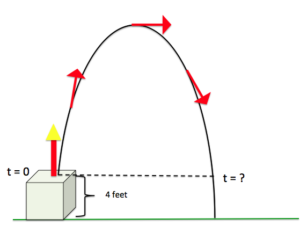
[reveal-answer q=”198118″]Show Solution[/reveal-answer]
[hidden-answer a=”198118″]
Read and understand: We are given that the height of the rocket is 4 feet from the ground on it’s way back down. We want to know how long it has taken the rocket to get to that point in it’s path, we are going to solve for t.
Translate: Substitute h = 4 into the formula for height, and try to get zero on one side since we know we can use the zero product principle to solve polynomials.
Write and Solve:
\(\begin{array}{l}h=−2t^{2}+7t+4\\4=-2t^2+7t+4\\\underline{-4}\,\,\,\,\,\,\,\,\,\,\,\,\,\,\,\,\,\,\,\,\,\,\,\,\,\,\,\,\,\underline{-4}\\0=-2t^2+7t\end{array}\)
Now we can factor out a t from each term:
\(0=t\left(-2t+7\right)\)
Solve each equation for t using the zero product principle:
\(\begin{array}{l}t=0\text{ OR }-2t+7=0\\\,\,\,\,\,\,\,\,\,\,\,\,\,\,\,\,\,\,\,\,\,\,\,\,\,\,\,\,\,\,\,\,\,\,\,\,\,\,\underline{-7}\,\,\,\,\,\,\,\underline{-7}\\\,\,\,\,\,\,\,\,\,\,\,\,\,\,\,\,\,\,\,\,\,\,\,\,\,\,\,\,\,\,\,\,\,\,\,\,\,\,\frac{-2t}{-2}=\frac{-7}{-2}\\\,\,\,\,\,\,\,\,\,\,\,\,\,\,\,\,\,\,\,\,\,\,\,\,\,\,\,\,\,\,\,\,\,\,\,\,\,\,t=\frac{7}{2}=3.5\end{array}\)
Interpret: It doesn’t make sense for us to choose t=0 because we are interested in the amount of time that has passed when the projectile is 4 feet from hitting the ground on it’s way back down. We will choose t=3.5
Answer
\(t=3.5\text{ seconds }\)
[/hidden-answer]
The video that follows presents another example of solving a quadratic equation that represents parabolic motion.
In this section we introduced the concept of projectile motion, and showed that it can be modeled with a quadratic polynomial. While the models used in these examples are simple, the concepts and interpretations are the same. The methods used to solve quadratic polynomials that don’t factor easily are many and well known, it is likely you will come across more in your studies.
Summary
You can find the solutions, or roots, of quadratic equations by setting one side equal to zero, factoring the polynomial, and then applying the Zero Product Property. The Principle of Zero Products states that if \(a=0\) or \(b=0\), or both a and b are 0. Once the polynomial is factored, set each factor equal to zero and solve them separately. The answers will be the set of solutions for the original equation.
Not all solutions are appropriate for some applications. In many real-world situations, negative solutions are not appropriate and must be discarded.
- "Cops' Latest Tool in High-speed Chases: GPS Projectiles." CBSNews. CBS Interactive, n.d. Web. 14 June 2016. ↵
- Revision and Adaptation. Provided by: Lumen Learning. License: CC BY: Attribution
- Pythagorean Theorem, Description and Examples. Provided by: Lumen Learning. License: CC BY: Attribution
- Factoring Application - Find the Lengths of Three Sides of a Right Triangle (Pythagorean Theorem). Authored by: James Sousa (Mathispower4u.com) for Lumen Learning. Located at: https://youtu.be/xeP5pRBqsNs. License: CC BY: Attribution
- Parabolic motion description and example. Provided by: Lumen Learning. License: CC BY: Attribution
- Factoring Application - Find the Time When a Projectile Hits and Ground. Authored by: James Sousa (Mathispower4u.com) for Lumen Learning. Located at: https://youtu.be/hsWSzu3KcPU. License: CC BY: Attribution
- Ex 2: Quadratic Equation App - Find the Dimensions of a Rectangle Given Area (Factoring). Authored by: James Sousa (Mathispower4u.com) . Located at: https://youtu.be/PvXsWZp588o. License: CC BY: Attribution
- Ex: Solve a Quadratic Equation Using Factor By Grouping. Authored by: James Sousa (Mathispower4u.com) . Located at: https://youtu.be/04zEXaOiO4U. License: CC BY: Attribution
- Ex: Factor and Solve Quadratic Equation - Trinomial a = -1. Authored by: James Sousa (Mathispower4u.com) . Located at: https://youtu.be/nZYfgHygXis. License: CC BY: Attribution
- Unit 12: Factoring, from Developmental Math: An Open Program. Provided by: Monterey Institute of Technology and Education. Located at: http://nrocnetwork.org/resources/downloads/nroc-math-open-textbook-units-1-12-pdf-and-word-formats/. License: CC BY: Attribution
- Celestial Navigation Math. Authored by: TabletClass Math. Located at: https://www.youtube.com/watch?v=XWLZKmPU17M. License: All Rights Reserved. License Terms: Standard Youtube License
- Pythagorean Theorem. Provided by: Wikipedia. Located at: https://en.Wikipedia.org/wiki/Pythagorean_theorem. License: CC BY-SA: Attribution-ShareAlike
- Parabolic water trajectory. Authored by: By GuidoB. Located at: https://commons.wikimedia.org/w/index.php?curid=8015696. License: CC BY-SA: Attribution-ShareAlike


